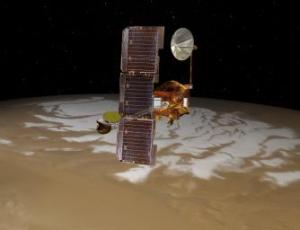Aug 8 2014
NASA's Mars Odyssey spacecraft has successfully adjusted the timing of its orbit around Mars as a defensive precaution for a comet's close flyby of Mars on Oct. 19, 2014.
 NASA's Mars Odyssey spacecraft passes above Mars' south pole in this artist's concept illustration. The spacecraft has been orbiting Mars since October 24, 2001. Image Credit: NASA/JPL
NASA's Mars Odyssey spacecraft passes above Mars' south pole in this artist's concept illustration. The spacecraft has been orbiting Mars since October 24, 2001. Image Credit: NASA/JPL
The orbiter fired thrusters for five and a half seconds on Tuesday, Aug. 5. The maneuver was calculated to place the orbiter behind Mars during the half hour on the flyby date when dust particles released from comet C/2013 A1 Siding Spring are most likely to reach Mars. The nucleus of the comet will miss Mars by about one-third of the distance between Earth and Earth's moon.
"The modeling predictions for comet Siding Spring suggest a dust-particle impact would not be likely in any case, but this maneuver has given us an added protection," said Mars Odyssey Project Manager David Lehman of NASA's Jet Propulsion Laboratory, Pasadena, California. "Those dust particles will be traveling so fast that even one hit could end our mission."
The Tuesday maneuver did not change the shape of Odyssey's orbit, but tweaked the timing. The spacecraft is in a near-polar orbit, circling Mars about once every two hours. The maneuver used four trajectory-correction thrusters, which each provide about 5 pounds (22 newtons) of force. It consumed less than one percent of the orbiter's remaining fuel.
Mars Odyssey has worked at the Red Planet longer than any other Mars mission in history. NASA launched the spacecraft on April 7, 2001, and Odyssey arrived at Mars Oct. 24, 2001. Besides conducting its own scientific observations, the mission provides a communication relay for robots on the Martian surface.
Odyssey is managed by JPL for NASA's Science Mission Directorate in Washington. Lockheed Martin Space Systems in Denver built the spacecraft. JPL and Lockheed Martin collaborate on operating the spacecraft. The California Institute of Technology in Pasadena manages JPL for NASA.
For more about the Mars Odyssey mission, visit: http://mars.jpl.nasa.gov/odyssey
For more about comet C/2013 A1 Siding Spring, visit: http://mars.nasa.gov/comets/sidingspring